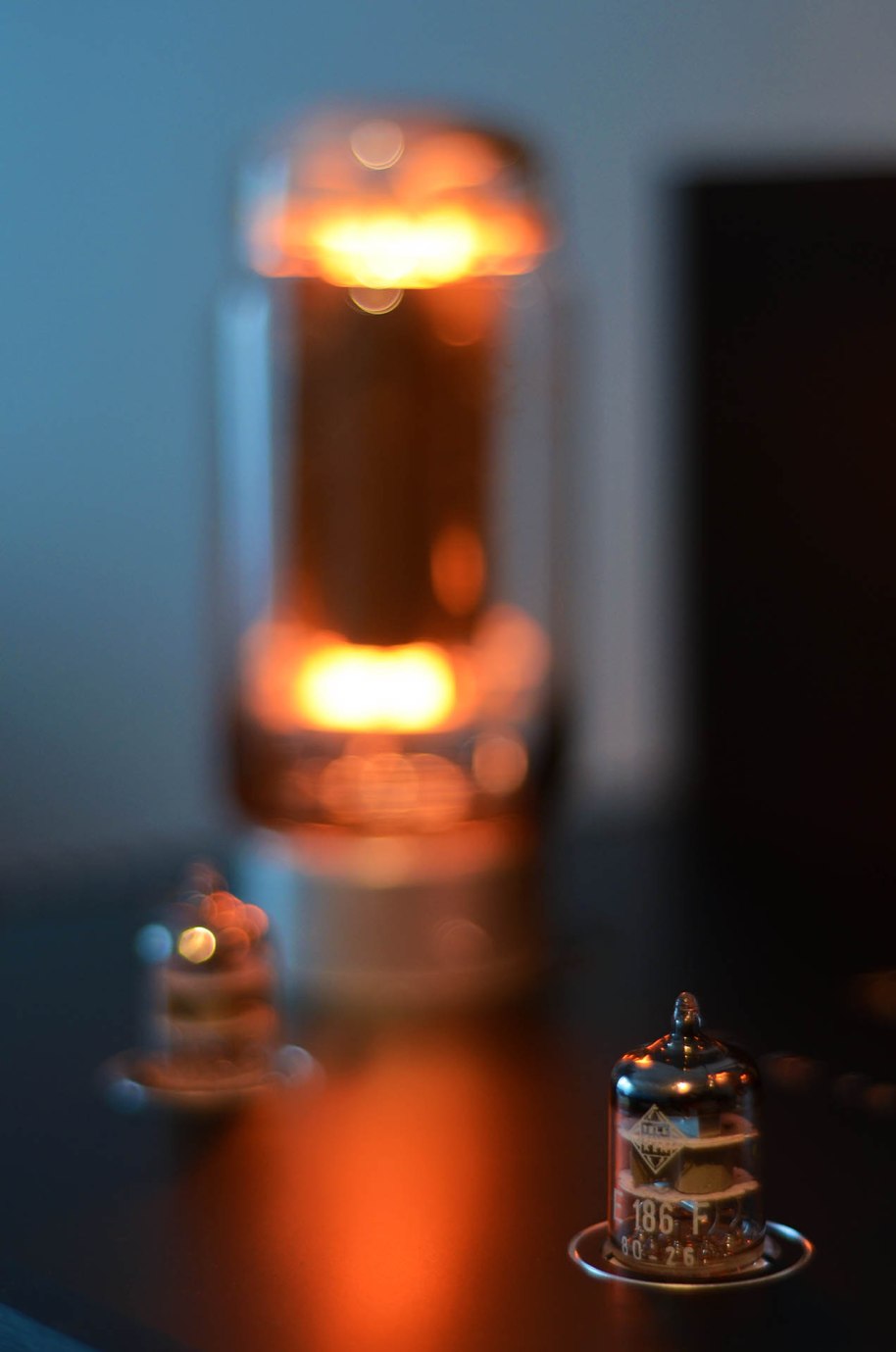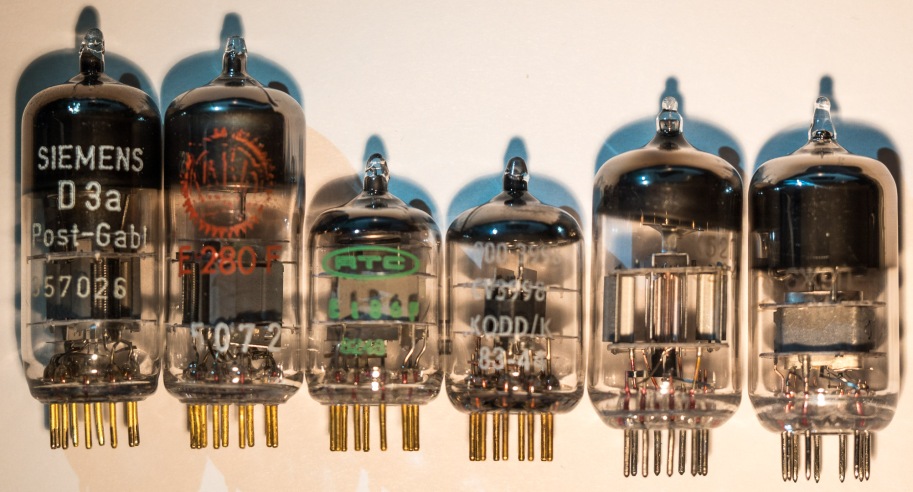GM-70 SE amplifier
18.09.2014

My best project so far. A few years of research and prototyping went into it, but the result is worth it – this is a superb amplifier, one of the best I have ever heard.
* The GM70 tube
The GM70 is a Russian-made DHT, originally used as a modulator in military AM transmitters. It is very linear and works really well as a power amplifier, producing more than 20W of power in single-ended configuration, which is absolutely remarkable.
It has a directly heated thoriated tungsten cathode that emits a bright light when heated.
There are two versions of this tube: one with a graphite plate and one with a copper plate. They don’t sound the same: in this amplifier the graphite plates give a deeper bass, while the copper plates have a more refined and detailed sound.
With 125W plate dissipation and 60W filaments, this tube is quite power hungry. The very high supply voltage of 1100V demands very careful wiring, insulation and selection of reliable components. It’s a difficult tube to work with, but it rewards you with more than 20W RMS of single-ended triode power! That’s twice as much as the average 300B amp.
The output transformers that I chose are the Lundahl LL1688, these sound very good.
I have tried the LL1688 with 5.5k and 9k primary load impedance – I kept the higher load. With this higher impedance, the power is slightly reduced, but the harmonic distortions are also sensibly lower.

The copper plate GM-70 emits a warm, strong light
* How to drive it?
The GM-70 needs a quite strong driver, capable of a large voltage swing. In this amp, the power tubes are biased at between -80 and -120 volts, depending on the tube type (graphite/copper).
Normally, two stages of preamplification would be needed to achieve this. But there is a family of small pentodes that, wired as triodes and CCS loaded, have high amplification and transconductance and low output impedance and can swing a whole lot of voltage. These little super-tubes were designed and built in the golden-age of vacuum amplification, with superb craftsmanship and a precision and quality that today’s production tubes cannot rival (and I am afraid we will never again see this quality level in tubes manufacturing).
I’m talking about the likes of the D3a, E180F, E186F, E280F, 8667, 6688, CV3998 and their russian equivalents – 6J52P, 6J11P, 6J9P (all have the same pinout). The D3a, for example, has a µ=77 and S=41mA/V when wired as a triode, and can easily drive the GM70 all the way with a normal 2v RMS line input.
After some listening, I selected the E186F for its more refined and open sound. It has a lower µ of around 45 so it needs more input voltage for the amplifier to reach full power, and my separate preamplifier takes care of that.

Siemens D3a, Valvo E280F, RTC E186F, Mullard CV3998, 6J52P, 6J9P
The first stage is loaded by a high-quality, very low noise CCS (constant current source) made with depletion mode MOSFETs and biased by a single unbypassed resistor (the degeneration is very low). A green LED or a string of three SiC Schottky diodes can also be used for biasing (and with this kind of LED/diode fixed bias you can roll in any of the tubes mentioned above without changing anything else in the circuit).
This stage is AC coupled to the power tube using a high quality capacitor – I found the russian Teflon FT-3 to be superb sounding and great value.
* How to bias the power tubes?
Cathode bias would waste a lot of PSU voltage, so fixed bias is the good choice here. I used a quite revolutionary solution : a constant current source generates a clean voltage drop over the 100K grid resistor. The bias power supply is kept completely out of the signal’s path by the CCS’s enormous impedance! I have built this amp with classic fixed bias also, and this CCS bias sounds better.

The amplifier internals
* How to heat the power tubes’ filaments?
I used Rod Coleman’s DHT regulator modules. Again, the CCSs are put to good use, as they provide a constant current for the filaments. This means there is no power surge on startup, when the filaments are cold, prolonging the tubes’ lives!
It also means the power supplies are kept out of the music path, and there is zero hum in the output.
* How to power the amplifier?
The power supplies are a critical component of any audio device. The very high voltage that the GM70 requires is a big challenge – working with 1100 volts can be really dangerous! Please don’t attempt to build this if you are not experienced with electrical safety.
In this amp, each stage has its own power supply circuit: 2x 1100v for the power tubes HV, 360v for the driver stage HV, 250v for biasing, 2x 20v for the DHTs and 6.3v for the driver heating. The final capacitors in the HV supplies are MKP + PIO.
The driver stage doesn’t need a big capacitor because of the constant current source.
All of the high voltage PSUs are stabilized (not regulated!), including the 1100v, and they have a “soft start” feature. The big power transformers are protected againts inrush current.
A tube rectifier would have wasted too much power in the 1100v supply, so I went with HEXFRED fast soft recovery diodes. I have also tried SiC Schottky diodes here, but I think they sound a bit bright.
The power supply circuits need to dissipate a lot of heat, so I built the PSU in a separate enclosure, with big radiators. The connexions to the amp enclosure is done with Mil-spec connectors and 2000v rated wires, with triple insulation.

The power supply and controller unit.
* How to make sure it runs smoothly?
With fixed bias amps there is always a possibility that a power tube starts drawing excessive current, because there is no cathode resistor to prevent that. So a protection mechanism is necessary.
I’ve done that with an Arduino Nano microcontroller: several hundred times per second it checks the instant and average current through the power tubes and instantly cuts the power in case of an anomaly. It also has temperature sensors and controls the start-up sequence (inrush protection, tube warm up).
* The VxD Aeneus v2.1 GM-70 amp schematics:
* How does it sound?
Absolutely fantastic!






